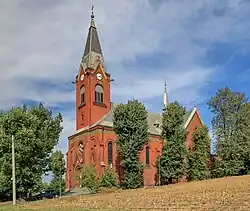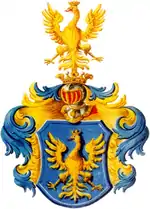Stonava
Stonawa | |
|---|---|
 Church of Saint Mary Magdalene | |
 Flag  Coat of arms | |
 Stonava Location in the Czech Republic | |
| Coordinates: 49°49′0″N 18°31′31″E / 49.81667°N 18.52528°E | |
| Country | |
| Region | Moravian-Silesian |
| District | Karviná |
| First mentioned | 1388 |
| Area | |
| • Total | 13.87 km2 (5.36 sq mi) |
| Elevation | 259 m (850 ft) |
| Population (2023-01-01)[1] | |
| • Total | 1,772 |
| • Density | 130/km2 (330/sq mi) |
| Time zone | UTC+1 (CET) |
| • Summer (DST) | UTC+2 (CEST) |
| Postal code | 735 34 |
| Website | www |
Stonava (Polish: ⓘ, German: Steinau) is a municipality and village in Karviná District in the Moravian-Silesian Region of the Czech Republic. It has about 1,800 inhabitants. The municipality has a significant Polish minority.
Etymology
The name is of topographic origin, derived from the older name of the Stonávka River, which itself denoted a murmuring river. As Stonawa it was then mentioned in 1432, a German name Steinau appeared in the 18th century.[2]
Geography
Stonava lies about 4 kilometres (2 mi) south of Karviná and 14 kilometres (9 mi) east of Ostrava. It lies in the historical region of Cieszyn Silesia, in the Ostrava Basin lowland. The Stonávka River flows through the municipality.
History
The first written mention of Stonava (as Stoen) is from 1388, when lord Hanke von Stoen was mentioned as owner of Stonava. In 1580, a fortress in Stonava is first mentioned. The most notable owners of the fortress and the village was the Larisch family, which owned it shortly after 1590 and then from 1743 until 1945.[3]
Politically the village belonged then to the Duchy of Teschen, formed in 1290 in the process of feudal fragmentation of Poland and was ruled by a local branch of Silesian Piast dynasty. In 1327 the duchy became a fee of the Kingdom of Bohemia, which after 1526 became a part of the Habsburg monarchy.
The village became a seat of a Catholic parish, mentioned in the register of Peter's Pence payment from 1447 among the 50 parishes of Teschen deanery as Stinavia.[4] After the 1540s Protestant Reformation prevailed in the Duchy of Teschen and a local Catholic church was taken over by Lutherans. It was taken from them by a special commission and given back to the Roman Catholic Church in 1654.[5]
After 1870, the village with a purely agricultural character changed its character with the development of hard coal mining. Many people subsisted on mining and new immigrants came, especially from the foothills and Galicia.[3]
After the Revolutions of 1848 in the Austrian Empire, a modern municipal division was introduced in the re-established Austrian Silesia. The village as a municipality was subscribed at least since 1880 to political district and legal district of Freistadt.
According to the censuses conducted in 1880–1910 the population of the municipality grew from 2,040 in 1880 to 3,952 in 1910. The majority were Polish-speakers (growing from 90.1% in 1880 to 99% in 1910), accompanied by Czech-speakers (at most 158 or 7.8% in 1880, then dropping to between 0.1% and 0.4%) and German-speakers (at most 43 or 2.1% in 1880). In terms of religion, in 1910 the majority were Roman Catholics (77.7%), followed by Protestants (21.1%), 3 Jews and 42 others.[6]
After World War I, the Polish–Czechoslovak War and the division of Cieszyn Silesia in 1920, the municipality became a part of Czechoslovakia. Following the Munich Agreement, in October 1938 together with the Trans-Olza region it was annexed by Poland, administratively organised in Frysztat County of Silesian Voivodeship.[7] The municipality was then annexed by Nazi Germany at the beginning of World War II. After the war it was restored to Czechoslovakia.
Demographics
Polish minority makes up 14.4% of the population.[8]
|
|
| ||||||||||||||||||||||||||||||||||||||||||||||||||||||
| Source: Censuses[9][10] | ||||||||||||||||||||||||||||||||||||||||||||||||||||||||
Sights
The landmark of the village is the Church of Saint Mary Magdalene. Its existence was first documented in 1447. The old church was replaced by a new wooden building in 1808 and then by a brick building in 1906–1910.[3]
Notable people
- Augustyn Łukosz (1884–1940), Polish politician
- Władysław Santarius (1915–1989), Polish Lutheran pastor
- Bruno Matykiewicz (born 1959), Polish weightlifter
Gallery
 Grave of 20 Polish soldiers murdered by Czech legionists on 26 January 1919
Grave of 20 Polish soldiers murdered by Czech legionists on 26 January 1919 Workers' House
Workers' House Lutheran church
Lutheran church Polish primary school
Polish primary school
References
- ↑ "Population of Municipalities – 1 January 2023". Czech Statistical Office. 2023-05-23.
- ↑ Mrózek, Robert (1984). Nazwy miejscowe dawnego Śląska Cieszyńskiego [Local names of former Cieszyn Silesia] (in Polish). Katowice: University of Silesia in Katowice. p. 166. ISSN 0208-6336.
- 1 2 3 "Historie" (in Czech). Obec Stonava. Retrieved 2022-01-11.
- ↑ "Registrum denarii sancti Petri in archidiaconatu Opoliensi sub anno domini MCCCCXLVII per dominum Nicolaum Wolff decretorum doctorem, archidiaconum Opoliensem, ex commissione reverendi in Christo patris ac domini Conradi episcopi Wratislaviensis, sedis apostolice collectoris, collecti". Zeitschrift des Vereins für Geschichte und Alterthum Schlesiens (in German). Breslau: H. Markgraf. 27: 361–372. 1893. Retrieved 21 July 2014.
- ↑ Broda, Jan (1992). "Materiały do dziejów Kościoła ewangelickiego w Księstwie Cieszyńskim i Państwie Pszczyńskim w XVI i XVII wieku". Z historii Kościoła ewangelickiego na Śląsku Cieszyńskim (in Polish). Katowice: Dom Wydawniczy i Księgarski „Didache“. pp. 259–260. ISBN 83-85572-00-7.
- ↑ Piątkowski, Kazimierz (1918). Stosunki narodowościowe w Księstwie Cieszyńskiem (in Polish). Cieszyn: Macierz Szkolna Księstwa Cieszyńskiego. pp. 274, 291.
- ↑ "Ustawa z dnia 27 października 1938 r. o podziale administracyjnym i tymczasowej organizacji administracji na obszarze Ziem Odzyskanych Śląska Cieszyńskiego". Dziennik Ustaw Śląskich (in Polish). Katowice. nr 18/1938, poz. 35. 31 October 1938. Retrieved 1 July 2014.
- ↑ "Population Census 2021: Population by selected ethnicity". Public database. Czech Statistical Office. 2021-03-27.
- ↑ "Historický lexikon obcí České republiky 1869–2011 – Okres Karviná" (in Czech). Czech Statistical Office. 2015-12-21. pp. 5–6.
- ↑ "Population Census 2021: Population by sex". Public Database. Czech Statistical Office. 2021-03-27.

